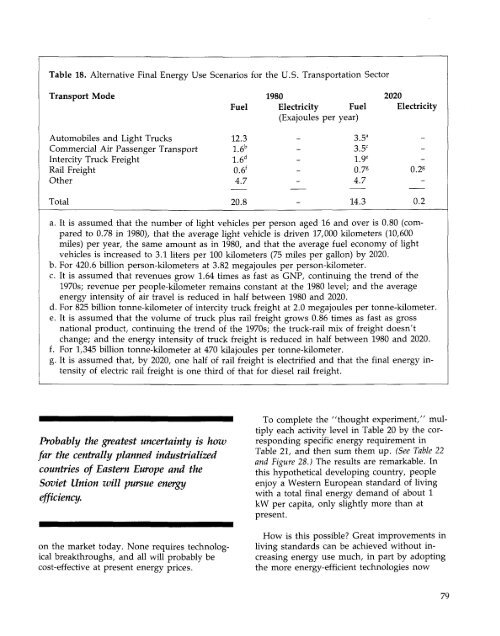ENERGY FOR A SUSTAINABLE WORLD - World Resources Institute
ENERGY FOR A SUSTAINABLE WORLD - World Resources Institute
ENERGY FOR A SUSTAINABLE WORLD - World Resources Institute
Create successful ePaper yourself
Turn your PDF publications into a flip-book with our unique Google optimized e-Paper software.
Table 18. Alternative Final Energy Use Scenarios for the U.S. Transportation Sector<br />
Transport Mode<br />
Fuel<br />
1980<br />
Electricity<br />
(Exajoules<br />
Fuel<br />
per year)<br />
2020<br />
Electricity<br />
Automobiles and Light Trucks<br />
Commercial Air Passenger Transport<br />
Intercity Truck Freight<br />
Rail Freight<br />
Other<br />
12.3<br />
1.6 b<br />
1.6 d<br />
0.6 f<br />
4.7<br />
_<br />
_<br />
_<br />
-<br />
-<br />
3.5 a<br />
3.5 C<br />
1.9 e<br />
0.7 s<br />
4.7<br />
_<br />
-<br />
-<br />
0.2 s<br />
-<br />
Total<br />
20.8 14.3 0.2<br />
a. It is assumed that the number of light vehicles per person aged 16 and over is 0.80 (compared<br />
to 0.78 in 1980), that the average light vehicle is driven 17,000 kilometers (10,600<br />
miles) per year, the same amount as in 1980, and that the average fuel economy of light<br />
vehicles is increased to 3.1 liters per 100 kilometers (75 miles per gallon) by 2020.<br />
b. For 420.6 billion person-kilometers at 3.82 megajoules per person-kilometer.<br />
c. It is assumed that revenues grow 1.64 times as fast as GNP, continuing the trend of the<br />
1970s; revenue per people-kilometer remains constant at the 1980 level; and the average<br />
energy intensity of air travel is reduced in half between 1980 and 2020.<br />
d. For 825 billion tonne-kilometer of intercity truck freight at 2.0 megajoules per tonne-kilometer.<br />
e. It is assumed that the volume of truck plus rail freight grows 0.86 times as fast as gross<br />
national product, continuing the trend of the 1970s; the truck-rail mix of freight doesn't<br />
change; and the energy intensity of truck freight is reduced in half between 1980 and 2020.<br />
f. For 1,345 billion tonne-kilometer at 470 kilajoules per tonne-kilometer.<br />
g. It is assumed that, by 2020, one half of rail freight is electrified and that the final energy intensity<br />
of electric rail freight is one third of that for diesel rail freight.<br />
Probably the greatest uncertainty is how<br />
far the centrally planned industrialized<br />
countries of Eastern Europe and the<br />
Soviet Union will pursue energy<br />
efficiency.<br />
on the market today. None requires technological<br />
breakthroughs, and all will probably be<br />
cost-effective at present energy prices.<br />
To complete the "thought experiment," multiply<br />
each activity level in Table 20 by the corresponding<br />
specific energy requirement in<br />
Table 21, and then sum them up. (See Table 22<br />
and Figure 28.) The results are remarkable. In<br />
this hypothetical developing country, people<br />
enjoy a Western European standard of living<br />
with a total final energy demand of about 1<br />
kW per capita, only slightly more than at<br />
present.<br />
How is this possible? Great improvements in<br />
living standards can be achieved without increasing<br />
energy use much, in part by adopting<br />
the more energy-efficient technologies now<br />
79

















